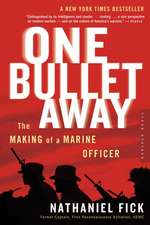House of War: The Pentagon and the Disastrous Rise of American Power
Autor James Carrollen Limba Engleză Paperback – 3 iun 2007
From
the
National
Book
Award–winning
author
ofAn
American
RequiemandConstantine's
Swordcomes
a
sweeping
yet
intimate
look
at
the
Pentagon
and
its
vast—often
hidden—impact
on
America.
This landmark, myth-shattering work chronicles the most powerful institution in America, the people who created it, and the pathologies it has spawned. James Carroll proves a controversial thesis: the Pentagon has, since its founding, operated beyond the control of any force in government or society. It is the biggest, loosest cannon in American history, and no institution has changed this country more. To argue his case, he marshals a trove of often chilling evidence. He recounts how "the Building" and its denizens achieved what Eisenhower called "a disastrous rise of misplaced power"—from the unprecedented aerial bombing of Germany and Japan during World War II to the "shock and awe" of Iraq. He charts the colossal U.S. nuclear buildup, which far outpaced that of the USSR, and has outlived it. He reveals how consistently the Building has found new enemies just as old threats—and funding—evaporate. He demonstrates how Pentagon policy brought about U.S. indifference to an epidemic of genocide during the 1990s. And he shows how the forces that attacked the Pentagon on 9/11 were set in motion exactly sixty years earlier, on September 11, 1941, when ground was broken for the house of war.
Carroll draws on rich personal experience (his father was a top Pentagon official for more than twenty years) as well as exhaustive research and dozens of extensive interviews with Washington insiders. The result is a grand yet intimate work of history, unashamedly polemical and personal but unerringly factual. With a breadth and focus that no other book could muster, it explains what America has become over the past sixty years.
This landmark, myth-shattering work chronicles the most powerful institution in America, the people who created it, and the pathologies it has spawned. James Carroll proves a controversial thesis: the Pentagon has, since its founding, operated beyond the control of any force in government or society. It is the biggest, loosest cannon in American history, and no institution has changed this country more. To argue his case, he marshals a trove of often chilling evidence. He recounts how "the Building" and its denizens achieved what Eisenhower called "a disastrous rise of misplaced power"—from the unprecedented aerial bombing of Germany and Japan during World War II to the "shock and awe" of Iraq. He charts the colossal U.S. nuclear buildup, which far outpaced that of the USSR, and has outlived it. He reveals how consistently the Building has found new enemies just as old threats—and funding—evaporate. He demonstrates how Pentagon policy brought about U.S. indifference to an epidemic of genocide during the 1990s. And he shows how the forces that attacked the Pentagon on 9/11 were set in motion exactly sixty years earlier, on September 11, 1941, when ground was broken for the house of war.
Carroll draws on rich personal experience (his father was a top Pentagon official for more than twenty years) as well as exhaustive research and dozens of extensive interviews with Washington insiders. The result is a grand yet intimate work of history, unashamedly polemical and personal but unerringly factual. With a breadth and focus that no other book could muster, it explains what America has become over the past sixty years.
Preț: 143.31 lei
Nou
Puncte Express: 215
Preț estimativ în valută:
27.42€ • 29.32$ • 22.86£
27.42€ • 29.32$ • 22.86£
Carte disponibilă
Livrare economică 28 martie-11 aprilie
Livrare express 13-19 martie pentru 90.74 lei
Preluare comenzi: 021 569.72.76
Specificații
ISBN-13: 9780618872015
ISBN-10: 0618872019
Pagini: 688
Ilustrații: 16 pages of b-w photos
Dimensiuni: 152 x 229 x 43 mm
Greutate: 0.71 kg
Ediția:Reprint
Editura: HMH Books
Colecția Mariner Books
Locul publicării:United States
ISBN-10: 0618872019
Pagini: 688
Ilustrații: 16 pages of b-w photos
Dimensiuni: 152 x 229 x 43 mm
Greutate: 0.71 kg
Ediția:Reprint
Editura: HMH Books
Colecția Mariner Books
Locul publicării:United States
Recenzii
"A
prodigious
historical
synthesis,
with
pressing
importance
for
our
times,
and
also
a
deeply
engaging
story."
--Tracy
Kidder,
author
of
My
Detachment:
A
Memoir
House of War is a masterful achievement...[Carroll's] prose is elegant, his viewpoint bold." --Howard Zinn, author of The People's History of the United States
"[Carroll has] the historical depth, elegance of style, and moral complexity to have taken the full measure of [the Pentagon]." --Bill McKibben, author of The End of Nature
"One cannot understand the impact of the Pentagon on US foreign policy...without reading James Carroll's House of War." --Lawrence Korb, former Undersecretary of Defence under Ronald Reagan
[An] unequivocally mesmerizing account. . . . Certain to be one of the most talked-about nonfiction books of the season."
Booklist, ALA
"[James Carroll] brings to shocking life the truth of Randolph Bourne's dictum: 'War is the health of the state.'" --Garry Wills, author of Nixon Agonistes and Henry Adams and the Making of America
"Altogether excellent, and essential for understanding the birth of America's empire." Kirkus Reviews, Starred
"An aggressively compelling history." Publishers Weekly, Starred
House of War is a masterful achievement...[Carroll's] prose is elegant, his viewpoint bold." --Howard Zinn, author of The People's History of the United States
"[Carroll has] the historical depth, elegance of style, and moral complexity to have taken the full measure of [the Pentagon]." --Bill McKibben, author of The End of Nature
"One cannot understand the impact of the Pentagon on US foreign policy...without reading James Carroll's House of War." --Lawrence Korb, former Undersecretary of Defence under Ronald Reagan
[An] unequivocally mesmerizing account. . . . Certain to be one of the most talked-about nonfiction books of the season."
Booklist, ALA
"[James Carroll] brings to shocking life the truth of Randolph Bourne's dictum: 'War is the health of the state.'" --Garry Wills, author of Nixon Agonistes and Henry Adams and the Making of America
"Altogether excellent, and essential for understanding the birth of America's empire." Kirkus Reviews, Starred
"An aggressively compelling history." Publishers Weekly, Starred
Extras
ONE
ONE WEEK IN 1943
1. Hell’s Bottom
A year after the Al Qaeda attack, at a rededication ceremony on September 11, 2002, much was made of the post-9/11 repairs having been completed in a mere twelve months. No one seemed to know that the entire Building had been constructed from start to finish in less than sixteen months. It was made of cement for which 700,000 tons of sand were dredged from the Potomac riverbed next to the site. The river’s edge is key to the Building’s impression, evoking a forbidden temple of the timeless past, as if looming over the ancient Nile.1 The picturesque lagoon that sets off the River Entrance, like a plaza waiting to receive the barge of Cleopatra, is a vestige of that dredging.2 Relatively little steel was used in the construction — those ramps instead of elevators — because it was needed just then for bullets, shells, and tanks. Planners took for granted that once the war emergency had passed, the hulking edifice would be handed over for civilian use: a depot for government records or — and this is what my mother told me, which is why I always believed it, even after learning it was a myth — a facility for the care of wounded and disabled veterans, the ramps built for wheelchairs and gurneys. The largest hospital in the world. My mother’s devotion to this idea was sacralized when my brother Joe was stricken with polio, making her a haunter of hospitals, a connoisseur of ramps. Joe’s polio, in turn, transformed into worship her devotion to the similarly stricken, but nobly unbowed, President Roosevelt. He was photographed visiting the Building just before its completion in January 1943, but there is no record of his using a wheelchair there.
In fact, Roosevelt was deeply conflicted about the Pentagon. As assistant secretary of the Navy during WorldWar I, he had ordered the construction of barracks-like “tempos” all over Washington, and these eyesores were still there twenty years later, despoiling especially the Mall between the Lincoln Memorial and the Washington Monument. The structures were a source of self-rebuke to Roosevelt. The War Department alone occupied seventeen separate facilities around Washington. To consolidate the offices in one handsome place, FDR had personally overseen the construction of a new headquarters building at 21st Street in Foggy Bottom, but no sooner was it completed than World War II broke out. By mid- 1941, the Army had mushroomed to a million and a half men; the new headquarters was instantly inadequate, and senior Army officials told the president they would never use it.3 Though its entrance was decorated by a huge, undiplomatic martial mural — helmeted soldiers in combat — the building would become the headquarters of the State Department, which it remains to this day.
The size of the space was not the only issue. The freshly empowered Army wanted its new building to be set apart from the so-called Federa West Executive Area, apart from entanglements with, and the limits of, the seat of government. In a time of peril, the Army was not about to be treated as just another bureaucratic function, alongside Interior and Commerce and Indian Affairs. The Army would transcend. Senior military officials immediately began scouting sites outside the city — this despite the explicit terms of congressional appropriations for construction within Washington.4 A site in Virginia appealed to the Army because, for one thing, District of Columbia architectural supervision would not hinder the mammoth scale envisioned by departmental planners. Yet even across the river the initial site selection proved controversial. The D.C. Fine Arts Commission, chaired by Roosevelt’s cousin Frederick A. Delano, reached across the Potomac to denounce the “flagrant disregard”5 of context in the Army’s wish to build at the western end of Memorial Bridge. The site was then occupied by Arlington Farms, an agricultural research facility — all that was left of Robert E. Lee’s original plantation, the rest of which had long before been seized by the federal government to serve as the national cemetery. Recovering from the punitive impulse of that requisition, Washington had, in the 1920s, established a symbol of reconciliation between North and South by aligning an axis along Memorial Bridge between Lee’s becolumned mansion atop the hill at Arlington and the Lincoln Memorial, which was completed in 1922. Joined to Lincoln in this way, Lee was thus linked along the Mall to George Washington and the Capitol. The proposed new War Department building, just below the Lee mansion and directly on that axis, would destroy the geographic symbol of national reconciliation.
When that was pointed out too President Roosevelt, he ordered the War Department building moved about a mile downriver. At the same time, considering the architects’ plansssss for the hulking structure, FDR ordered the size of the building reduced by half. Among other considerations, the president expressed concern for the psychological effect on those who would be employed amid such dominating impersonality.6 He also affirmed that, after “the present emergency,” the War Department headquarters would be returned to Washington where it belonged; no permanent headquarters building would be necessary in Virginia. Roosevelt found himself declaring that the Army could make do, as the Navy would, with yet more tempos. (The Navy Annex was constructed to be temporary, but to this day it sits on the Arlington ridge, above the Pentagon.)When the general in charge of the project objected to these terms, the president said, “My dear General, I’m still Commander-in-Chief of the Army.”7 The general complied, but only partially. The new downriver site was accepted — an unsightly shack-ridden wasteland called Hell’s Bottom. It was a former airfield and railroad yard littered with abandoned tin hangars and rusted-out boxcars. But without Roosevelt’s knowledge, the general declined to reduce the size of the Building, and with the help of Virginia congressmen, he protected the appropriations needed to make the construction permanent. By then the Building’s architects, led by G. Edwin Bergstrom, who had also designed the Hollywood Bowl, had completed drawings for the upriver site at Arlington Farms. The original design for that now abandoned location called for a simple rectangular footprint, but access roads required one corner of the rectangle to be cut off, leaving an asymmetrical five-sided building. What Bergstrom did was to even up the five sides, producing — voilr — the Pentagon. When the site was moved downriver, the polygonal shape was no longer required by the limits of the roadways, but such was the hurried pace of the project that the architects did not change the design. Eventually Bergstrom and others would mythologize the pentagonal form of the War Department headquarters as an echo of Napoleonic-era fortress architecture.8 The true, entirely mundane origin of the design would be forgotten.
Over the next year, more than a hundred architects and nearly as many engineers worked around the clock in those abandoned airplane hangars, turning out drawings for the more than fifteen thousand laborers, who often didn’t wait for specs. Pearl Harbor was attacked almost three months after groundbreaking, and from then on the already quickened pace of construction was redoubled. “How big should I make that beam across the third floor?” one architect asked another, who replied, “I don’t know. They installed it yesterday.”9 * * * Supervising all of this work was a Corps of Engineers colonel named Leslie R. Groves, who was forty-five years old when appointed to head up Pentagon construction. He was a burly, corpulent man whose belly protruded like lips over his brass-buckled belt.10 A man of the job, Groves was an important military manager. In charge of the Army’s crash building program across the country (in 1940 the Corps’s construction budget skyrocketed from $20 million to $10 billion), he had already purchased half the lumber in the United States.11 Born into an Army family four years after the Battle of Wounded Knee, in 1890, which marked the end of the Indian wars, Groves had spent part of his childhood at Fort Apache, Arizona, living in the house of a man famous for killing Indians.12 His lifelong hero was General William Tecumseh Sherman, whose “march to the sea” across Georgia legitimized the spirit of total war, which after the CivilWar was unleashed on Native Americans.
Groves began as a student at the Massachusetts Institute of Technology, but when his older brother died in 1914 — of a disease contracted at the same Arlington Farms that would much later be the first site proposed for the Pentagon — Groves transferred to West Point. From then on he wore a mustache, which did nothing to soften his stern, unfriendly demeanor. Work in the Corps of Engineers was essentially a matter of management, and Groves proved himself again and again. By the time he was put in charge of Pentagon construction, his most notable prior service had been in Nicaragua, developing plans for a second (never undertaken) canal across the Central American isthmus.13 As the Pentagon neared completion, Groves was promoted to brigadier general, although for a reason having to do with his next project, not this one. Among his last decisions in Arlington was one that provided the new Building with separate eating and lavatory accommodations for “colored people” and whites. The dining areas for blacks would be in the basement, and on the other floors, at each corridor junction, double toilet facilities would be built, separated by race. When President Roosevelt visited the Building shortly before its dedication, he asked why there were so many lavatories (more than two hundred), and he was told that the Army was abiding by Virginia’s racial laws. Roosevelt had issued an order prohibiting such discrimination throughout the U.S. military only six months earlier, and he told Groves to get rid of the Whites Only signs at once. Groves obeyed. Because he was overridden by the president, the Pentagon would for a long time be the only place in Virginia where segregation was not allowed.14 Within days of Roosevelt’s visit to the new War Department headquarters, at an understated ceremony presided over by Secretary of War Henry L. Stimson, the Pentagon was dedicated. Wartime exigencies eclipsed such a formality in the memoirs and memories of witnesses. Honor guards would have mounted battle flags in mahogany stands, and portraits of former secretaries of war would have been unveiled. One imagines the Army band playing martial music. Perhaps a ribbon was cut. It was January 15, 1943.15
Copyright © 2006 by James Carroll. Reprinted with permission by Houghton Mifflin Company.
ONE WEEK IN 1943
1. Hell’s Bottom
A year after the Al Qaeda attack, at a rededication ceremony on September 11, 2002, much was made of the post-9/11 repairs having been completed in a mere twelve months. No one seemed to know that the entire Building had been constructed from start to finish in less than sixteen months. It was made of cement for which 700,000 tons of sand were dredged from the Potomac riverbed next to the site. The river’s edge is key to the Building’s impression, evoking a forbidden temple of the timeless past, as if looming over the ancient Nile.1 The picturesque lagoon that sets off the River Entrance, like a plaza waiting to receive the barge of Cleopatra, is a vestige of that dredging.2 Relatively little steel was used in the construction — those ramps instead of elevators — because it was needed just then for bullets, shells, and tanks. Planners took for granted that once the war emergency had passed, the hulking edifice would be handed over for civilian use: a depot for government records or — and this is what my mother told me, which is why I always believed it, even after learning it was a myth — a facility for the care of wounded and disabled veterans, the ramps built for wheelchairs and gurneys. The largest hospital in the world. My mother’s devotion to this idea was sacralized when my brother Joe was stricken with polio, making her a haunter of hospitals, a connoisseur of ramps. Joe’s polio, in turn, transformed into worship her devotion to the similarly stricken, but nobly unbowed, President Roosevelt. He was photographed visiting the Building just before its completion in January 1943, but there is no record of his using a wheelchair there.
In fact, Roosevelt was deeply conflicted about the Pentagon. As assistant secretary of the Navy during WorldWar I, he had ordered the construction of barracks-like “tempos” all over Washington, and these eyesores were still there twenty years later, despoiling especially the Mall between the Lincoln Memorial and the Washington Monument. The structures were a source of self-rebuke to Roosevelt. The War Department alone occupied seventeen separate facilities around Washington. To consolidate the offices in one handsome place, FDR had personally overseen the construction of a new headquarters building at 21st Street in Foggy Bottom, but no sooner was it completed than World War II broke out. By mid- 1941, the Army had mushroomed to a million and a half men; the new headquarters was instantly inadequate, and senior Army officials told the president they would never use it.3 Though its entrance was decorated by a huge, undiplomatic martial mural — helmeted soldiers in combat — the building would become the headquarters of the State Department, which it remains to this day.
The size of the space was not the only issue. The freshly empowered Army wanted its new building to be set apart from the so-called Federa West Executive Area, apart from entanglements with, and the limits of, the seat of government. In a time of peril, the Army was not about to be treated as just another bureaucratic function, alongside Interior and Commerce and Indian Affairs. The Army would transcend. Senior military officials immediately began scouting sites outside the city — this despite the explicit terms of congressional appropriations for construction within Washington.4 A site in Virginia appealed to the Army because, for one thing, District of Columbia architectural supervision would not hinder the mammoth scale envisioned by departmental planners. Yet even across the river the initial site selection proved controversial. The D.C. Fine Arts Commission, chaired by Roosevelt’s cousin Frederick A. Delano, reached across the Potomac to denounce the “flagrant disregard”5 of context in the Army’s wish to build at the western end of Memorial Bridge. The site was then occupied by Arlington Farms, an agricultural research facility — all that was left of Robert E. Lee’s original plantation, the rest of which had long before been seized by the federal government to serve as the national cemetery. Recovering from the punitive impulse of that requisition, Washington had, in the 1920s, established a symbol of reconciliation between North and South by aligning an axis along Memorial Bridge between Lee’s becolumned mansion atop the hill at Arlington and the Lincoln Memorial, which was completed in 1922. Joined to Lincoln in this way, Lee was thus linked along the Mall to George Washington and the Capitol. The proposed new War Department building, just below the Lee mansion and directly on that axis, would destroy the geographic symbol of national reconciliation.
When that was pointed out too President Roosevelt, he ordered the War Department building moved about a mile downriver. At the same time, considering the architects’ plansssss for the hulking structure, FDR ordered the size of the building reduced by half. Among other considerations, the president expressed concern for the psychological effect on those who would be employed amid such dominating impersonality.6 He also affirmed that, after “the present emergency,” the War Department headquarters would be returned to Washington where it belonged; no permanent headquarters building would be necessary in Virginia. Roosevelt found himself declaring that the Army could make do, as the Navy would, with yet more tempos. (The Navy Annex was constructed to be temporary, but to this day it sits on the Arlington ridge, above the Pentagon.)When the general in charge of the project objected to these terms, the president said, “My dear General, I’m still Commander-in-Chief of the Army.”7 The general complied, but only partially. The new downriver site was accepted — an unsightly shack-ridden wasteland called Hell’s Bottom. It was a former airfield and railroad yard littered with abandoned tin hangars and rusted-out boxcars. But without Roosevelt’s knowledge, the general declined to reduce the size of the Building, and with the help of Virginia congressmen, he protected the appropriations needed to make the construction permanent. By then the Building’s architects, led by G. Edwin Bergstrom, who had also designed the Hollywood Bowl, had completed drawings for the upriver site at Arlington Farms. The original design for that now abandoned location called for a simple rectangular footprint, but access roads required one corner of the rectangle to be cut off, leaving an asymmetrical five-sided building. What Bergstrom did was to even up the five sides, producing — voilr — the Pentagon. When the site was moved downriver, the polygonal shape was no longer required by the limits of the roadways, but such was the hurried pace of the project that the architects did not change the design. Eventually Bergstrom and others would mythologize the pentagonal form of the War Department headquarters as an echo of Napoleonic-era fortress architecture.8 The true, entirely mundane origin of the design would be forgotten.
Over the next year, more than a hundred architects and nearly as many engineers worked around the clock in those abandoned airplane hangars, turning out drawings for the more than fifteen thousand laborers, who often didn’t wait for specs. Pearl Harbor was attacked almost three months after groundbreaking, and from then on the already quickened pace of construction was redoubled. “How big should I make that beam across the third floor?” one architect asked another, who replied, “I don’t know. They installed it yesterday.”9 * * * Supervising all of this work was a Corps of Engineers colonel named Leslie R. Groves, who was forty-five years old when appointed to head up Pentagon construction. He was a burly, corpulent man whose belly protruded like lips over his brass-buckled belt.10 A man of the job, Groves was an important military manager. In charge of the Army’s crash building program across the country (in 1940 the Corps’s construction budget skyrocketed from $20 million to $10 billion), he had already purchased half the lumber in the United States.11 Born into an Army family four years after the Battle of Wounded Knee, in 1890, which marked the end of the Indian wars, Groves had spent part of his childhood at Fort Apache, Arizona, living in the house of a man famous for killing Indians.12 His lifelong hero was General William Tecumseh Sherman, whose “march to the sea” across Georgia legitimized the spirit of total war, which after the CivilWar was unleashed on Native Americans.
Groves began as a student at the Massachusetts Institute of Technology, but when his older brother died in 1914 — of a disease contracted at the same Arlington Farms that would much later be the first site proposed for the Pentagon — Groves transferred to West Point. From then on he wore a mustache, which did nothing to soften his stern, unfriendly demeanor. Work in the Corps of Engineers was essentially a matter of management, and Groves proved himself again and again. By the time he was put in charge of Pentagon construction, his most notable prior service had been in Nicaragua, developing plans for a second (never undertaken) canal across the Central American isthmus.13 As the Pentagon neared completion, Groves was promoted to brigadier general, although for a reason having to do with his next project, not this one. Among his last decisions in Arlington was one that provided the new Building with separate eating and lavatory accommodations for “colored people” and whites. The dining areas for blacks would be in the basement, and on the other floors, at each corridor junction, double toilet facilities would be built, separated by race. When President Roosevelt visited the Building shortly before its dedication, he asked why there were so many lavatories (more than two hundred), and he was told that the Army was abiding by Virginia’s racial laws. Roosevelt had issued an order prohibiting such discrimination throughout the U.S. military only six months earlier, and he told Groves to get rid of the Whites Only signs at once. Groves obeyed. Because he was overridden by the president, the Pentagon would for a long time be the only place in Virginia where segregation was not allowed.14 Within days of Roosevelt’s visit to the new War Department headquarters, at an understated ceremony presided over by Secretary of War Henry L. Stimson, the Pentagon was dedicated. Wartime exigencies eclipsed such a formality in the memoirs and memories of witnesses. Honor guards would have mounted battle flags in mahogany stands, and portraits of former secretaries of war would have been unveiled. One imagines the Army band playing martial music. Perhaps a ribbon was cut. It was January 15, 1943.15
Copyright © 2006 by James Carroll. Reprinted with permission by Houghton Mifflin Company.
Cuprins
Prologue
•
xi
The
Invisible
Boy
One: ONE WEEK IN 1943 • 1 Hell’s Bottom. Unconditional Surrender. Operation Pointblank. LeMay.
The Whiz Kid. Leslie Groves Does It All. The Other September 11s
Two: THE ABSOLUTE WEAPON • 40 Truman’s “Decision.” Stimson’s Defense. Not Japan, but Moscow?
Atomic Forgetfulness. Groves’s Toboggan. The Second Coming in Wrath.
The Hamburg Threshold. After Dresden. The Babe Ruth of Bombers.
Born in Original Sin
Three: THE COLD WAR BEGINS • 103 Tendered a Commission. Stimson’s September 11. Forrestal Agonistes.
Kennan’s Mistake. Foundational Paranoia.War Inside the Pentagon.
Blockade and the Birth of the Air Force. The Russians Are Coming.
Navy Versus Air Force. That Cop
Four: SELF-FULFILLING PARANOIA • 161 Stalin’s Teeth. No to the Hydrogen Bomb. Nitze to the Rescue. Forrestal’s Ghost: NSC-68. Korea Saved Us. Truman’s Other Decision. The Test. Duck and Cover.Massive Retaliation. The Missed Opportunity. Defense Intellectuals. Operation Top Hat. The Gaither Report: Nitze Again
Five: THE TURNING POINT • 227 Life of the Pentagon. A Lark in Berlin. There Will Be War. Head to Richmond. Let Both Sides. The Need for New Intelligence.McNamara and LeMay. All-Out Spasm Attack. The Kaysen Memos. Edge of the Abyss. At American University.Why We Love Him
Six: THE EXORCISM • 293 Present at the Destruction. LeMay to the Absurd. Errors of the Mind.
Great White Whale.McNamara’s Endgame. From Disarmament to Arms Control. The Berrigan Brothers. Enter the ABM, Reenter Nitze. Nixon and Laird. Knockout Blow. Bombing the Pentagon? Not with a Bang
Seven: UPSTREAM • 345 Nuclear Priesthood. The Madman Theory. The Schlesinger Doctrine.
Enter Rumsfeld and Cheney. Jimmy Carter’s Question. The Frozen Smile. The People Are Heard. Be Not Afraid.We Win, You Lose, Sign Here. The Freeze. The Abolitionist. Sanctuary. Enter Gorbachev.
Answer to Forrestal
Eight: UNENDING WAR • 418 Into Plowshares. Back to Stimson. Operation Just Cause. Fool’s Game.
New World Order. The Chinese Word. Goldwater-Nichols. The Immigrant’s Son. Clinton’s Honor. Gays in the Military. The Real Contrast with Truman. The Nuclear Posture Review. The Balkan Wars.
Apostolic Succession. September 11, 2001
Epilogue: NEW WORLD ORDER • 491 National Memory. The Normalization of War. Instant Replay. National Security? Revenge. I Have a Dream
Acknowledgments • 515 Notes • 518 Bibliography • 609 Index • 623
One: ONE WEEK IN 1943 • 1 Hell’s Bottom. Unconditional Surrender. Operation Pointblank. LeMay.
The Whiz Kid. Leslie Groves Does It All. The Other September 11s
Two: THE ABSOLUTE WEAPON • 40 Truman’s “Decision.” Stimson’s Defense. Not Japan, but Moscow?
Atomic Forgetfulness. Groves’s Toboggan. The Second Coming in Wrath.
The Hamburg Threshold. After Dresden. The Babe Ruth of Bombers.
Born in Original Sin
Three: THE COLD WAR BEGINS • 103 Tendered a Commission. Stimson’s September 11. Forrestal Agonistes.
Kennan’s Mistake. Foundational Paranoia.War Inside the Pentagon.
Blockade and the Birth of the Air Force. The Russians Are Coming.
Navy Versus Air Force. That Cop
Four: SELF-FULFILLING PARANOIA • 161 Stalin’s Teeth. No to the Hydrogen Bomb. Nitze to the Rescue. Forrestal’s Ghost: NSC-68. Korea Saved Us. Truman’s Other Decision. The Test. Duck and Cover.Massive Retaliation. The Missed Opportunity. Defense Intellectuals. Operation Top Hat. The Gaither Report: Nitze Again
Five: THE TURNING POINT • 227 Life of the Pentagon. A Lark in Berlin. There Will Be War. Head to Richmond. Let Both Sides. The Need for New Intelligence.McNamara and LeMay. All-Out Spasm Attack. The Kaysen Memos. Edge of the Abyss. At American University.Why We Love Him
Six: THE EXORCISM • 293 Present at the Destruction. LeMay to the Absurd. Errors of the Mind.
Great White Whale.McNamara’s Endgame. From Disarmament to Arms Control. The Berrigan Brothers. Enter the ABM, Reenter Nitze. Nixon and Laird. Knockout Blow. Bombing the Pentagon? Not with a Bang
Seven: UPSTREAM • 345 Nuclear Priesthood. The Madman Theory. The Schlesinger Doctrine.
Enter Rumsfeld and Cheney. Jimmy Carter’s Question. The Frozen Smile. The People Are Heard. Be Not Afraid.We Win, You Lose, Sign Here. The Freeze. The Abolitionist. Sanctuary. Enter Gorbachev.
Answer to Forrestal
Eight: UNENDING WAR • 418 Into Plowshares. Back to Stimson. Operation Just Cause. Fool’s Game.
New World Order. The Chinese Word. Goldwater-Nichols. The Immigrant’s Son. Clinton’s Honor. Gays in the Military. The Real Contrast with Truman. The Nuclear Posture Review. The Balkan Wars.
Apostolic Succession. September 11, 2001
Epilogue: NEW WORLD ORDER • 491 National Memory. The Normalization of War. Instant Replay. National Security? Revenge. I Have a Dream
Acknowledgments • 515 Notes • 518 Bibliography • 609 Index • 623
Notă biografică
James Carroll was raised in Washington, D.C., and ordained to the Catholic priesthood in 1969. He served as a chaplain at Boston University from 1969 to 1974, then left the priesthood to become a writer. A distinguished scholar-
in-residence at Suffolk University, he is a columnist for the Boston Globe and a
regular contributor to the Daily Beast.
His critically admired books include Practicing Catholic, the National Book Award?winning An American Requiem, House of War, which won the first PEN/Galbraith Award, and the New York Times bestseller Constantine's Sword, now an acclaimed documentary.
Descriere
From
the
National
Book
Award–winning
author
of
An
American
Requiem
and
Constantine's
Sword
comes
a
sweeping
yet
intimate
look
at
the
Pentagon
and
its
vast
—
often
hidden
—
impact
on
America.
This landmark, myth-shattering work chronicles the most powerful institution in America, the people who created it, and the pathologies it has spawned. James Carroll proves a controversial thesis: the Pentagon has, since its founding, operated beyond the control of any force in government or society. It is the biggest, loosest cannon in American history, and no institution has changed this country more. To argue his case, he marshals a trove of often chilling evidence. He recounts how "the Building" and its denizens achieved what Eisenhower called "a disastrous rise of misplaced power" — from the unprecedented aerial bombing of Germany and Japan during World War II to the "shock and awe" of Iraq. He charts the colossal U.S. nuclear buildup, which far outpaced that of the USSR, and has outlived it. He reveals how consistently the Building has found new enemies just as old threats — and funding — evaporate. He demonstrates how Pentagon policy brought about U.S. indifference to an epidemic of genocide during the 1990s. And he shows how the forces that attacked the Pentagon on 9/11 were set in motion exactly sixty years earlier, on September 11, 1941, when ground was broken for the house of war.
Carroll draws on rich personal experience (his father was a top Pentagon official for more than twenty years) as well as exhaustive research and dozens of extensive interviews with Washington insiders. The result is a grand yet intimate work of history, unashamedly polemical and personal but unerringly factual. With a breadth and focus that no other book could muster, it explains what America has become over the past sixty years.
This landmark, myth-shattering work chronicles the most powerful institution in America, the people who created it, and the pathologies it has spawned. James Carroll proves a controversial thesis: the Pentagon has, since its founding, operated beyond the control of any force in government or society. It is the biggest, loosest cannon in American history, and no institution has changed this country more. To argue his case, he marshals a trove of often chilling evidence. He recounts how "the Building" and its denizens achieved what Eisenhower called "a disastrous rise of misplaced power" — from the unprecedented aerial bombing of Germany and Japan during World War II to the "shock and awe" of Iraq. He charts the colossal U.S. nuclear buildup, which far outpaced that of the USSR, and has outlived it. He reveals how consistently the Building has found new enemies just as old threats — and funding — evaporate. He demonstrates how Pentagon policy brought about U.S. indifference to an epidemic of genocide during the 1990s. And he shows how the forces that attacked the Pentagon on 9/11 were set in motion exactly sixty years earlier, on September 11, 1941, when ground was broken for the house of war.
Carroll draws on rich personal experience (his father was a top Pentagon official for more than twenty years) as well as exhaustive research and dozens of extensive interviews with Washington insiders. The result is a grand yet intimate work of history, unashamedly polemical and personal but unerringly factual. With a breadth and focus that no other book could muster, it explains what America has become over the past sixty years.


















